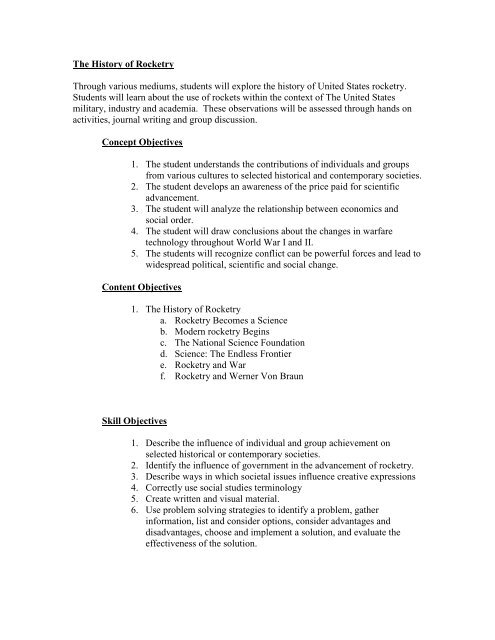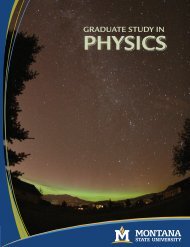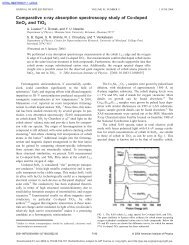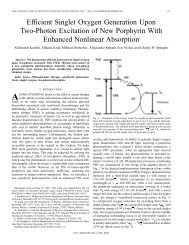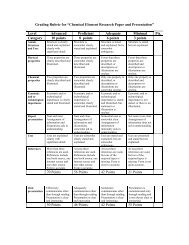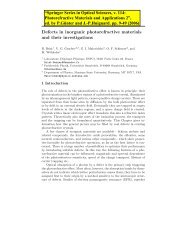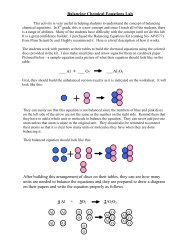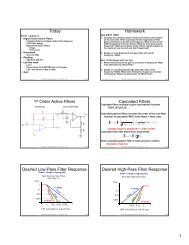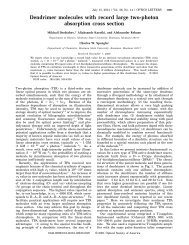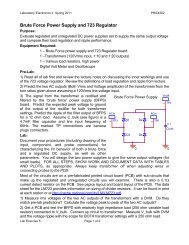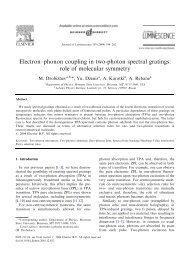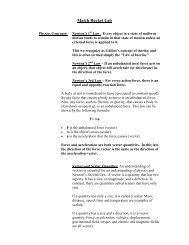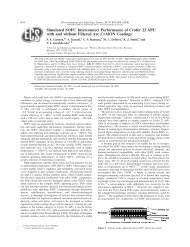The History of Rocketry lesson plan
The History of Rocketry lesson plan
The History of Rocketry lesson plan
Create successful ePaper yourself
Turn your PDF publications into a flip-book with our unique Google optimized e-Paper software.
<strong>The</strong> <strong>History</strong> <strong>of</strong> <strong>Rocketry</strong><br />
Through various mediums, students will explore the history <strong>of</strong> United States rocketry.<br />
Students will learn about the use <strong>of</strong> rockets within the context <strong>of</strong> <strong>The</strong> United States<br />
military, industry and academia. <strong>The</strong>se observations will be assessed through hands on<br />
activities, journal writing and group discussion.<br />
Concept Objectives<br />
1. <strong>The</strong> student understands the contributions <strong>of</strong> individuals and groups<br />
from various cultures to selected historical and contemporary societies.<br />
2. <strong>The</strong> student develops an awareness <strong>of</strong> the price paid for scientific<br />
advancement.<br />
3. <strong>The</strong> student will analyze the relationship between economics and<br />
social order.<br />
4. <strong>The</strong> student will draw conclusions about the changes in warfare<br />
technology throughout World War I and II.<br />
5. <strong>The</strong> students will recognize conflict can be powerful forces and lead to<br />
widespread political, scientific and social change.<br />
Content Objectives<br />
1. <strong>The</strong> <strong>History</strong> <strong>of</strong> <strong>Rocketry</strong><br />
a. <strong>Rocketry</strong> Becomes a Science<br />
b. Modern rocketry Begins<br />
c. <strong>The</strong> National Science Foundation<br />
d. Science: <strong>The</strong> Endless Frontier<br />
e. <strong>Rocketry</strong> and War<br />
f. <strong>Rocketry</strong> and Werner Von Braun<br />
Skill Objectives<br />
1. Describe the influence <strong>of</strong> individual and group achievement on<br />
selected historical or contemporary societies.<br />
2. Identify the influence <strong>of</strong> government in the advancement <strong>of</strong> rocketry.<br />
3. Describe ways in which societal issues influence creative expressions<br />
4. Correctly use social studies terminology<br />
5. Create written and visual material.<br />
6. Use problem solving strategies to identify a problem, gather<br />
information, list and consider options, consider advantages and<br />
disadvantages, choose and implement a solution, and evaluate the<br />
effectiveness <strong>of</strong> the solution.
7. Use decision-making strategies to identify a situation that requires a<br />
decision, gather information, identify options, predict consequences<br />
and take action to implement a decision.<br />
8. Identify key words, develop search strategies; locate appropriate and<br />
varied information sources; distinguish between primary and<br />
secondary sources.<br />
9. Identify the time, place, audience, purpose, and form <strong>of</strong> a source<br />
10. Recognize relevant facts and ideas in social studies documents;<br />
evaluate bias <strong>of</strong> sources/authors; classify information as fact/opinion<br />
11. Take notes, paraphrase, summarize<br />
12. Articulate a particular perspective/value orientation; demonstrate<br />
content knowledge; listen critically and build upon the ideas <strong>of</strong> others<br />
13. Identify central issue; formulate appropriate questions; identify<br />
multiple perspectives; compare and contrast; validate date using<br />
multiple sources; determine relevant information; paraphrase problem<br />
14. Distinguish between fact, opinion, and reasoned argument; clarify<br />
time, point <strong>of</strong> view and purpose; recognize stereotypes, clichés, bias,<br />
and propaganda techniques; identify message and target audience <strong>of</strong><br />
narrative and documents to determine credibility and authenticity<br />
Background Knowledge<br />
Resources<br />
Materials<br />
1. United States <strong>History</strong> up to World War I.<br />
1. Internet<br />
2. Atlases and Dictionaries<br />
3. Text book<br />
4. Maps<br />
5. Library media including books and periodicals<br />
6. Peer teachers<br />
1. LCD projector and screen<br />
2. Overhead projector<br />
3. Overhead transparencies<br />
4. Handouts
Lesson: Rocket Science<br />
Teacher: Kala Flentie<br />
Grade Level: 8<br />
Date: September 2008<br />
Lesson Duration: 50 minutes<br />
General Objectives:<br />
This <strong>lesson</strong> will cover the history <strong>of</strong> rocketry in the United Sates within the context <strong>of</strong><br />
academics, industry and the military.<br />
Learning Outcomes:<br />
1. Concept Objective:<br />
• <strong>The</strong> student understands the contributions <strong>of</strong> individuals and groups from<br />
various cultures to selected historical and contemporary societies.<br />
• <strong>The</strong> student develops an awareness <strong>of</strong> the price paid for scientific<br />
advancement.<br />
• <strong>The</strong> student will analyze the relationship between economics and social order.<br />
• <strong>The</strong> student will draw conclusions about the changes in warfare technology<br />
throughout World War I and II.<br />
• <strong>The</strong> students will recognize conflict can be powerful forces and lead to<br />
widespread political and social change.<br />
2. Skill-Development:<br />
• Describe the influence <strong>of</strong> individual and group achievement on selected<br />
historical or contemporary societies.<br />
• Correctly use social studies terminology<br />
• Use problem-solving strategies to identify a problem, gather information, list<br />
and consider options, consider advantages and disadvantages, choose and<br />
implement a solution, and evaluate the effectiveness <strong>of</strong> the solution.<br />
• Use decision-making strategies to identify a situation that requires a decision,<br />
gather information, identify options, predict consequences and take action to<br />
implement a decision.<br />
• Identify key words, develop search strategies; locate appropriate and varied<br />
information sources; distinguish between primary and secondary sources.<br />
• Identify the time, place, audience, purpose, and form <strong>of</strong> a source<br />
• Recognize relevant facts and ideas in social studies documents; evaluate bias<br />
<strong>of</strong> sources/authors; classify information as fact/opinion
• Take notes, paraphrase, summarize<br />
• Articulate a particular perspective/value orientation; demonstrate content<br />
knowledge; listen critically and build upon the ideas <strong>of</strong> others<br />
• Identify central issue; formulate appropriate questions; identify multiple<br />
perspectives; compare and contrast; validate date using multiple sources;<br />
determine relevant information; paraphrase problem<br />
• Distinguish between fact, opinion, and reasoned argument; clarify time, point<br />
<strong>of</strong> view and purpose; recognize stereotypes, clichés, bias, and propaganda<br />
techniques; identify message and target audience <strong>of</strong> narrative and documents<br />
to determine credibility and authenticity<br />
3. Process-Orientation:<br />
• <strong>The</strong> student will learn through analyzing and thinking critically about primary<br />
sources.<br />
• <strong>The</strong> student will learn through analyzing and thinking critically in group<br />
discussions about changes in the use <strong>of</strong> rocketry throughout United States<br />
history.<br />
• <strong>The</strong> student will learn through participatory note taking.<br />
• <strong>The</strong> student will learn through correctly identifying concepts from the text<br />
book.<br />
Rationale for Lesson:<br />
<strong>The</strong> <strong>lesson</strong> will be taught through the analysis <strong>of</strong> primary and secondary sources to foster<br />
critical thinking and independent analysis in the students. <strong>The</strong> students will also use<br />
group discussion to foster their understanding within the context <strong>of</strong> the French<br />
Revolution. Through the source documents and student text book, students will analyze<br />
why the French Revolution was a watershed event that changed Europe irrevocably.<br />
Instructional Procedure:<br />
Focusing Event:<br />
Students will be focused on the first activity <strong>of</strong> recording essential vocabulary from the<br />
overhead while attendance is taken.<br />
Teaching Methods and Student Activities:<br />
Students will break into groups <strong>of</strong> four. Each group will be given two handouts;<br />
Statement by the President upon signing Bill Creating the National Science Foundation<br />
(May 10, 1950) and Science, <strong>The</strong> Endless Frontier, a Report to the President by Vannevar<br />
Bush, Director <strong>of</strong> the Office <strong>of</strong> Scientific Research and Development (July 1945). Each<br />
student will read both documents and answer the corresponding questions for each<br />
document. <strong>The</strong> students will discuss the questions as a group; however, each student will<br />
be responsible for answering the questions. Students will also use the context <strong>of</strong> their<br />
textbook (Chapter 12, <strong>The</strong> Military-Industrial-University Complex, 1945-1990) to answer
the questions. Students will discuss the advancement <strong>of</strong> science and technology in times<br />
<strong>of</strong> war. Students will draw conclusions about scientific progress and United States<br />
military. Students will discuss the importance <strong>of</strong> establishing a national policy for<br />
science and sufficient military research during peacetime. After students discuss and<br />
write out their answers, each group will share their conclusions with the class. Students<br />
will be evaluated on the completion <strong>of</strong> their questions and participation in the group<br />
discussion- showing an understanding <strong>of</strong> the big idea. As each group reports their<br />
conclusions to the questions, the class will be allowed to respond and discuss the<br />
different conclusions made.<br />
(Teacher can devise questions from the primary source documents to fit their <strong>lesson</strong><br />
emphasis and to check for student understanding.)<br />
Closure:<br />
Students will respond to one aspect <strong>of</strong> the <strong>lesson</strong> that stood out to them. This will focus<br />
the student on the “big idea” <strong>of</strong> the day; prepare the students for upcoming primary<br />
source evaluation.<br />
Evaluation Procedures:<br />
Informally, the students will be evaluated on the information from class by responding to<br />
one aspect <strong>of</strong> the <strong>lesson</strong> at the end <strong>of</strong> the period. Students will also be evaluated based on<br />
the completion <strong>of</strong> the assigned questions in class. Throughout the class period, I will<br />
evaluate the students by spending time with each small group and facilitating discussion.<br />
By facilitating discussion, I will be able to evaluate each student’s grasp <strong>of</strong> the “Big Idea”<br />
for the day. Each group will be evaluated on their participation and the completion <strong>of</strong> the<br />
worksheet following the primary documents activity. Individually, each student will<br />
complete the questions, requiring them to think critically.<br />
Resources<br />
Materials<br />
Bibliography<br />
1. Internet<br />
2. Atlases and Dictionaries<br />
3. Handouts<br />
4. Text book: Major Problems in the <strong>History</strong> <strong>of</strong> American Technology.<br />
5. Maps<br />
1. Handouts<br />
Smith, Merritt Roe, Gregory Clancy. Major Problems in the <strong>History</strong> <strong>of</strong> American<br />
Technology. Houghton Mifflin. New York, 1998.


